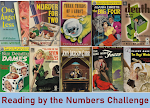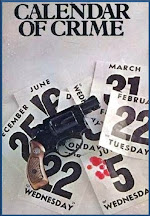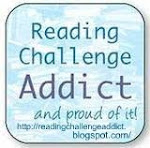Monday, March 11, 2013
Mary Poppins: Review
I picked up Mary Poppins by P. L. Travers a couple of years ago from a stack of free books here in the halls of the English Department. I was well-versed in the Disney film version starring Julie Andrews and Dick Van Dyke (having a small person who was fascinated with all things Disney when he was growing up helped fill in whatever Disney films I'd managed to miss when I was growing up)--but had never read the book. Stumbling across the 2013 Book to Movie Challenge sponsored by Katie over at Doing Dewey gave me the extra shove necessary to put Mary on my 2013 TBR list. Now to see what I think of the book and how it compares to Disney's version (which I have also re-watched this year)....as a bonus, I'll also briefly mention my experience seeing the staged version on Broadway in 2009.
The basic story in all three is pretty much the same. The Banks children have a way of running through nannies. They just don't seem to get along with any of them. That is until Mary Poppins arrives on the scene. She manages to tame the children and show them just how magical their lives can be. The children learn to love her and don't want her to leave...but she only promised to stay until the wind change.
Mary Poppins, the book, is a bit darker in tone than the Disney version. While still very magical, Travers' nanny is far less cheery than the one brought to life by Julie Andrews. Mary Poppins is sharp-tongued and vain--always peering at herself in shop windows and any available reflecting object. She still serves as a gatekeeper for the fantasies of childhood--talking animals, odd old ladies who serve up candy lady fingers (no, not cookies--real lady fingers made out of candy) and gingerbread, and tea parties on the ceiling, for example--but the fantasies are far more tinged with the harsh realities of life than the Disney film. The film does produce a bit of medicine to go with the sugar: there's the grimy woman who says "Granny will hide you" when the children run from the bank. Children may not get the overtones in that scene, but obviously Jane and Michael do NOT want to go with "Granny" in turn of the century London. And, of course, the moral of the story--that Mr. Banks is ignoring his children and should be spending time with them--is driven home.
The film nanny is obviously fond of the Banks children, even if she does insist that she couldn't possibly get attached to all the children she has cared for--after all, what would become of her if she did? In the book, it is much more difficult to discern any affection for the children and, quite honestly, she's often mean. Her appeal in the book is much more attached to her ability to provide magical adventures for the children and to represent the magic of childhood.
It has been reported in many places that P. L. Travers was very upset with Disney's adaptation of her novel. She particularly took exception to the use of animation. I find that rather astounding. Here is a woman who has incorporated the most unlikely scenes into her novels. She pens adventures that require talking animals; animals who behave like humans--from animals in charge of a human zoo to animals hosting a birthday party for Mary Poppins to having a cow dancing across the countryside and jumping over the moon--and she somehow believed Disney (one of pioneers in animation) was going to do the film as strictly live action? Seriously? I'm not sure how she thought he was going to pull that off successfully in the 1960s.
I've been to a production of the staged version on Broadway. It, of course, is all live action. And, while it is delightful in its own way, it definitely loses some of the magic of the children's fantasies. The best part of both the film and the staged production is the very lively dance number "Step in Time" with Bert and the chimney sweeps. Dick Van Dyke is absolutely brilliant in the film and Gavin Lee had a difficult legacy to live up to. Imagine my amazement when we watched him perform the "Step in Time" dance across the floor, up one side of the stage wall, across the ceiling (upside down), and down the opposite wall. A trick Fred Astaire did on film in Royal Wedding--except he did it in a revolving room and was never truly upside-down.
The stage version also incorporates a bit more of the darkness from the books. Rather than have Mary Poppins remain with the children throughout (as in the film), she leaves them between Acts I and II (as happens at the end of the first book). Mrs. Banks engages her husband's old nanny, Miss Andrews (aka the "Holy Terror"), but it winds up that Miss Andrews is a mean and nasty tyrant. After she has terrorized the children, Mary Poppins returns for a nanny showdown and runs the tyrant off. The play then proceeds to follow much of the film's action,
All three incarnations of Mary Poppins are enjoyable--however, if I have to rate them, then I'm afraid the book suffers at the expense of my previous experiences. This is one of the few instances where I would rate a film (and stage production) over the original novel. In order of preference: 1) film, 2) stage production, and 3) novel. Three stars for the book.
Subscribe to:
Post Comments (Atom)










.jpg)
.jpg)
.jpg)





















3 comments:
I enjoyed the Mary Poppins books, I think I've read two at least, maybe three. But the first time I read Mary Poppins I was disappointed that it wasn't like the movie. A few years later I was ready to appreciate it for what it was.
It sounds like the stage production incorporates details from Mary Poppins Comes Back.
These are books I've always wanted to read, but have never done so. You may just have given me the push I needed. Now I just need to find them.
Looks like an interesting read and love your analysis of the books vs. movie vs. show. I am surprised as you said that the author was disappointed with the Disney version. Of course, I love all things Disney and do find it the most magical place on earth :) Here's my review of Little Women for the Back to the Classics Challenge if you'd like to stop by.
Post a Comment